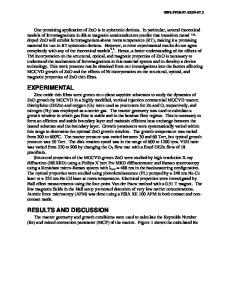Metal film deposition by laser breakdown chemical vapor deposition
- PDF / 451,315 Bytes
- 5 Pages / 594 x 810 pts Page_size
- 9 Downloads / 368 Views
Dielectric breakdown of gas mixtures can be used to deposit thin films by chemical vapor deposition with appropriate control of flow and pressure conditions to suppress gas-phase nucleation and particle formation. Using a pulsed CO 2 laser operating at 10.6 fi where there is no significant resonant absorption in any of the source gases, homogeneous films from several gasphase precursors have been sucessfully deposited by gas-phase laser pyrolysis. Nickel and molybdenum from the respective carbonyls representing decomposition chemistry and tungsten from the hexafluoride representing reduction chemistry have been demonstrated, in each case the gas precursor is buffered with argon to reduce the partial pressure of the reaetants and to induce breakdown. Films have been characterized by Auger electron spectroscopy, x-ray diffraction, transmission electron microscopy, pull tests, and resistivity measurements. The highest quality films have resulted from the nickel depositions. Detailed x-ray diffraction analysis of these films yields a very small domain size consistent with the low temperature of the substrate and the formation of metastable nickel carbide. Transmission electron microscopy supports this analysis.
I. INTRODUCTION Various techniques for laser-driven chemical vapor deposition (CVD) have been used to deposit metal films.!"3 Some of these techniques involve either laser heating of the substrate1 or the activation of the substrate surface by high-energy (UV) photons.2 Gasphase processing, such as that reported by the group of Collins3 with UV photons or the groups of Haggerty4 and Bilenchi5 using multiphoton processes, has the advantage that the surface energy available to atoms as they nucleate on the substrate can be minimized. By appropriate choice of materials, metastable forms can be produced if the surface energy available is insufficient to form the equilibrium (usually crystalline) phase. In fact, both the Haggerty and Bilenchi groups use gasphase processing specifically to produce amorphous silicon layers on heterogeneous substrates. We are investigating the use of laser techniques for the deposition of metal films from the gas phase in order to produce metastable metallic alloys and compounds. The results of this work on simple precursors represents a new technique for the deposition of elemental films and demonstrates the formation of a metastable crystalline compound. Dielectric breakdown has been used in gas mixtures to drive chemical reactions6 resulting in particulate formation by gas-phase nucleation and/or condensation. The formation of amorphous alloy particles by this technique has also been reported.7 These experiments used static cells and a pulsed CO 2 laser, the emphasis being on the results of the plasma chemistry in the laser-induced spark. By carefully controlling the pressure in a 420
J. Mater. Res. 1 (3), May/Jun 1986
http://journals.cambridge.org
flowing cell, we have been able to suppress gas-phase nucleation and obtain metal films8 directly from breakdown-induced reactions. I
Data Loading...











